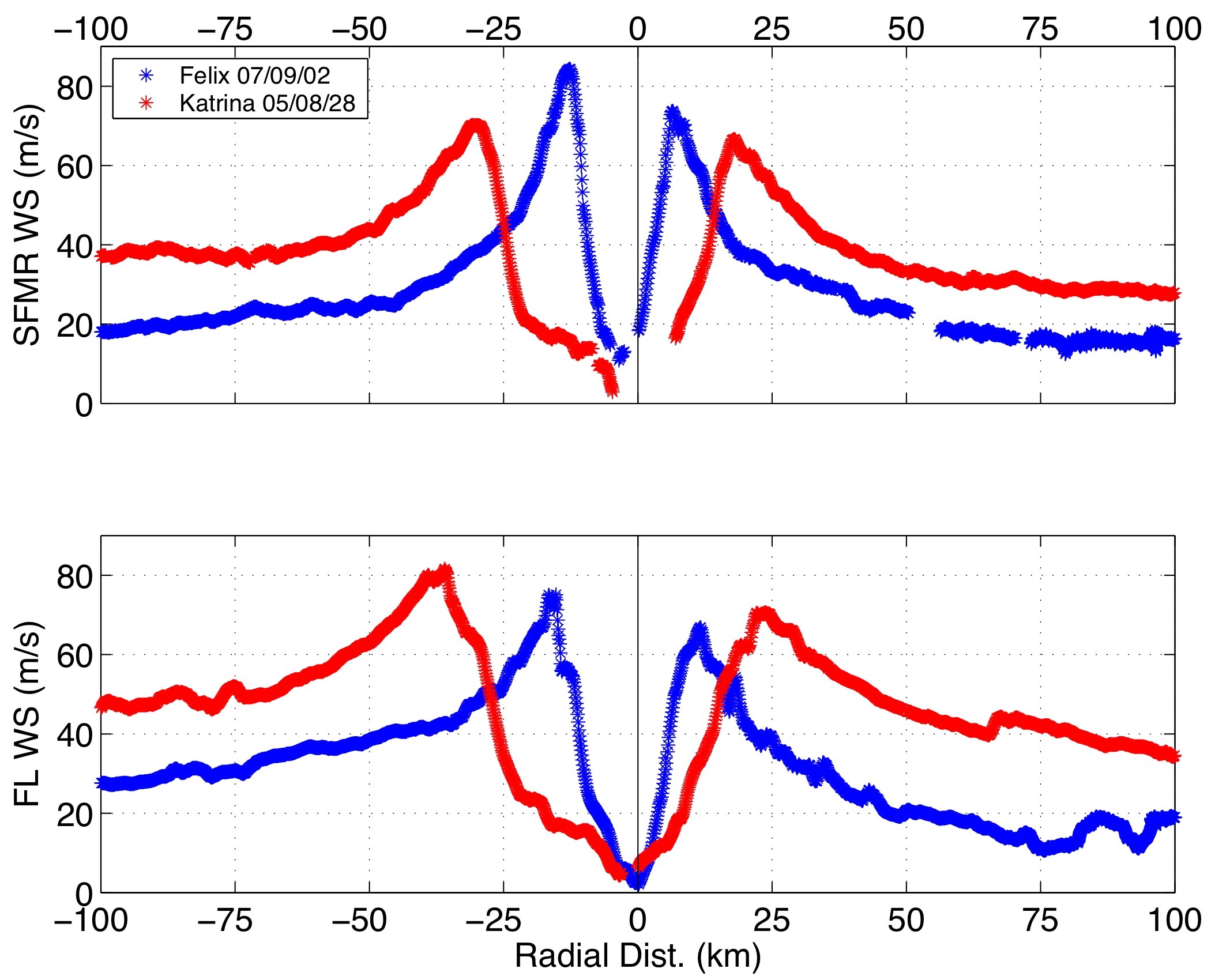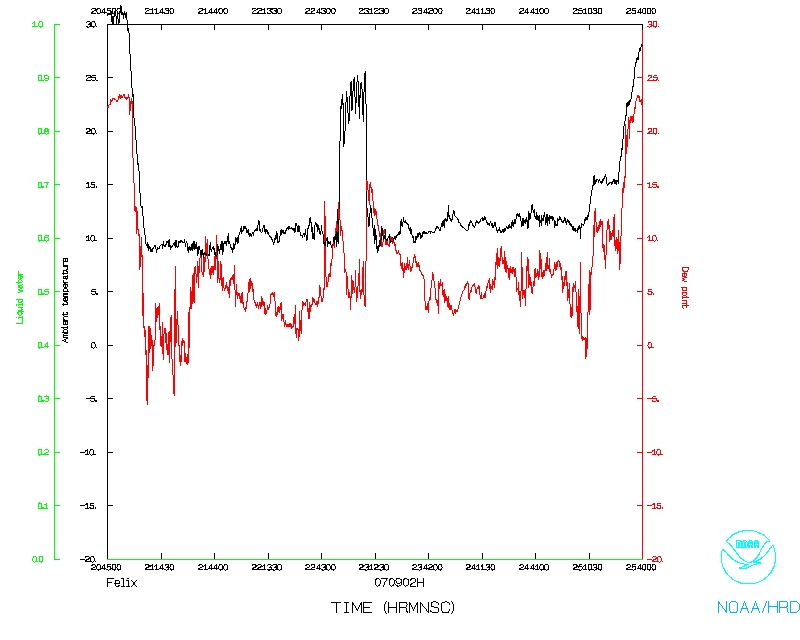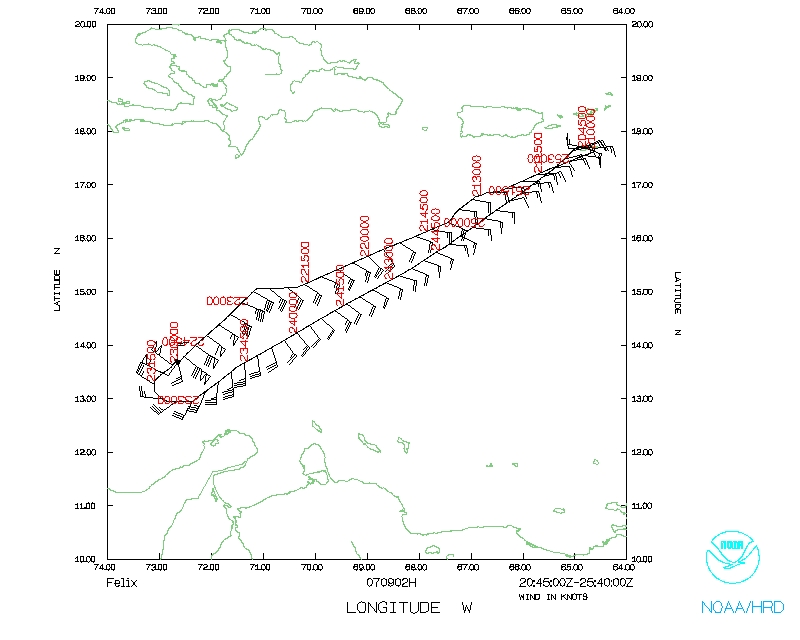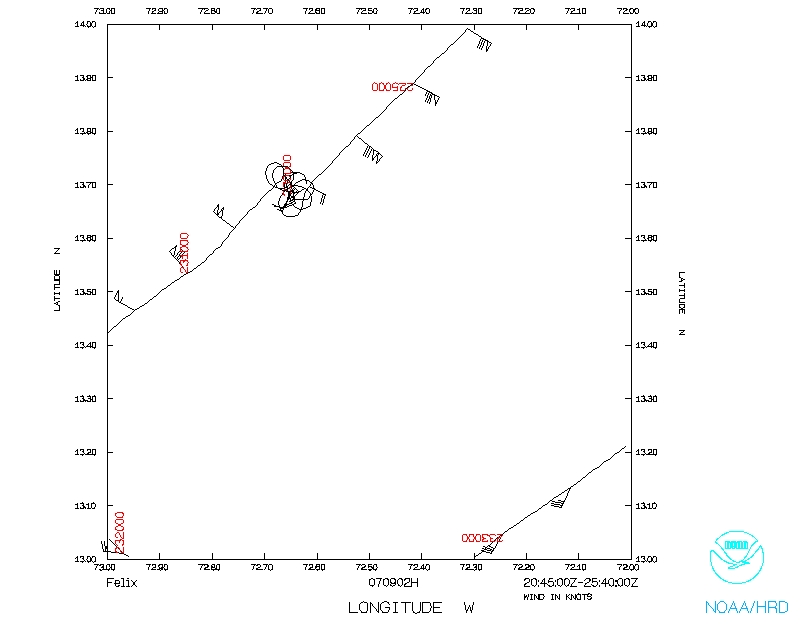Mission Summary
20070902H1 Aircraft 42RF
Felix flight 2007
Scientific Crew (42RF)
| Doppler/Dropsonde Scientist | Sim Aberson |
| Doppler/Dropsonde Scientist | Rob Rogers |
| IWRAP Scientists | Zorana Jelenak
Dani Esteban-Fernandez
Joe Manus
|
Flight Crew (42RF)
| Pilots | Carl Newman |
| Flight Director | Tom Shepherd |
| Navigator | Tim Gallagher |
| Flt. Eng. | Steve Wade |
| Data Tech | Sean McMillan
John Hill |
| Elec. Tech | Bill Olney |
Mission Plan :
This was the third planned flight in a series of flights into Felix to
gather 3-dimensional Doppler wind data during the entire life cycle of a
tropical cyclone. The plan was to approach Felix from the northeast and do
105 nm legs, each rotated 45 degrees downwind from the previous leg's
endpoint, for a total of four passes. Since the last of the four passes
ended on the west side, the plane was to turn around and perform one
final pass, then return to St. Croix.
Due to fix responsibility, at least two of the passes were to require
hunting for the center and releasing a dropwindsonde in the eye. The plan
was to accomplish this on the seond and fourth passes (north-south and
east-west) from 10,000 ft, with dropwindsondes released at the endpoints
and midway between the endpoints and the center. Due to IWRAP interests,
the two other passes would be done at 7000 ft, and the final pass at 5000
ft if flight felt this was safe. Eyewall soundings were planned for each
eyewall penetration.
N42RF will leave St. Croix, USVI at 04:00 PM AST, and recover at
St. Croix, USVI at 11:00 PM AST.
Mission summary and evaluation:
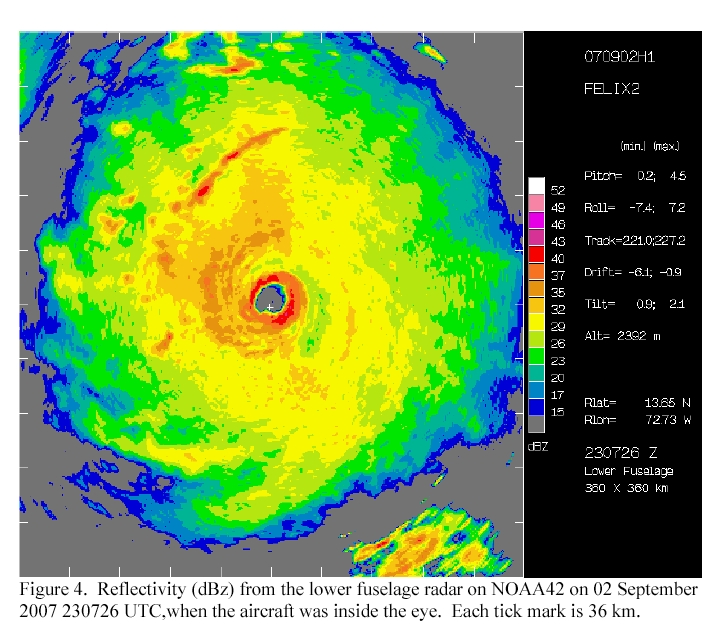 Takeoff was planned for 2000 UTC. However, the inertial navigation was
not set properly before takeoff, and the plane had to return to allow the
navigation to reset. Takeoff occurred about 40 minutes late. Because of
operational responsibility within a set time, the 10,000 ft legs were
switched to the first and third. Upon approach to the center, the endpoint
and midpoint dropwindsondes were released and provided good data. It was
apparent from both TA and nose radars that the storm had a very small eye
surrounded by a high-reflectivity ring, with purple on the nose radar.
Close to the eye, the flight-level and surface (SFMR) wind speeds were
relatively low, then began to spike rapidly. Upon penetration of the
eyewall, at 10,000 ft, the aircraft was pelted with hail, encountered
constant cloud-to-cloud lightning, and an updraft downdraft couplet that
caused the accelerometers to read +4G/-4G, higher than safe operations
allow, so the decision was made to abort the mission.
Takeoff was planned for 2000 UTC. However, the inertial navigation was
not set properly before takeoff, and the plane had to return to allow the
navigation to reset. Takeoff occurred about 40 minutes late. Because of
operational responsibility within a set time, the 10,000 ft legs were
switched to the first and third. Upon approach to the center, the endpoint
and midpoint dropwindsondes were released and provided good data. It was
apparent from both TA and nose radars that the storm had a very small eye
surrounded by a high-reflectivity ring, with purple on the nose radar.
Close to the eye, the flight-level and surface (SFMR) wind speeds were
relatively low, then began to spike rapidly. Upon penetration of the
eyewall, at 10,000 ft, the aircraft was pelted with hail, encountered
constant cloud-to-cloud lightning, and an updraft downdraft couplet that
caused the accelerometers to read +4G/-4G, higher than safe operations
allow, so the decision was made to abort the mission.
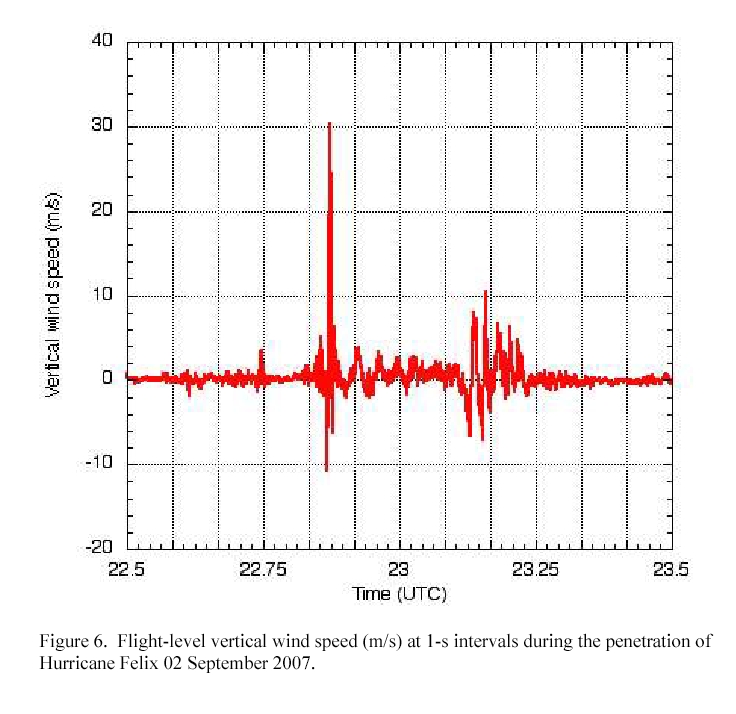
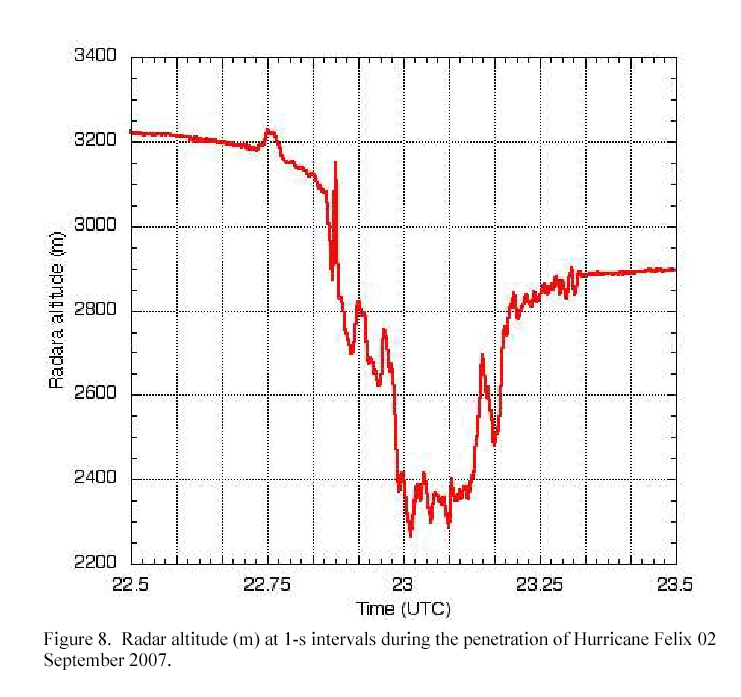
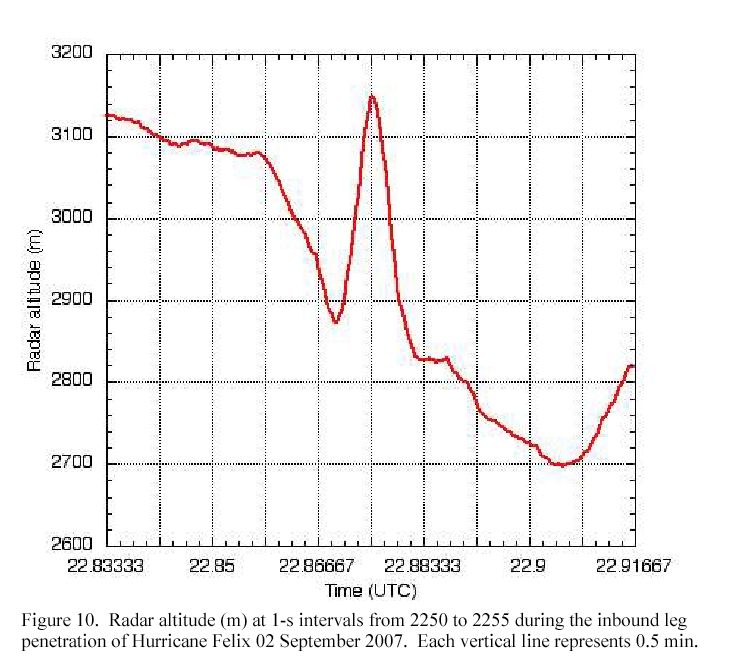 The SFMR reported wind speeds up to 163 kt, about the same as the flight-level
wind speed in the northeast quadrant. A dropwindsonde was released in the
northeastern eyewall and reported wind speeds greater than 90 m/s in a
thin layer between about 185 m and 165 m above the surface, accompanied by
radial inflow, outflow, then rapid inflow into the eye where the wind
speeds rapidly decreased to 27 m/s about 70 m above the surface. [All these
numbers are preliminary pending further analysis.]
The SFMR reported wind speeds up to 163 kt, about the same as the flight-level
wind speed in the northeast quadrant. A dropwindsonde was released in the
northeastern eyewall and reported wind speeds greater than 90 m/s in a
thin layer between about 185 m and 165 m above the surface, accompanied by
radial inflow, outflow, then rapid inflow into the eye where the wind
speeds rapidly decreased to 27 m/s about 70 m above the surface. [All these
numbers are preliminary pending further analysis.]
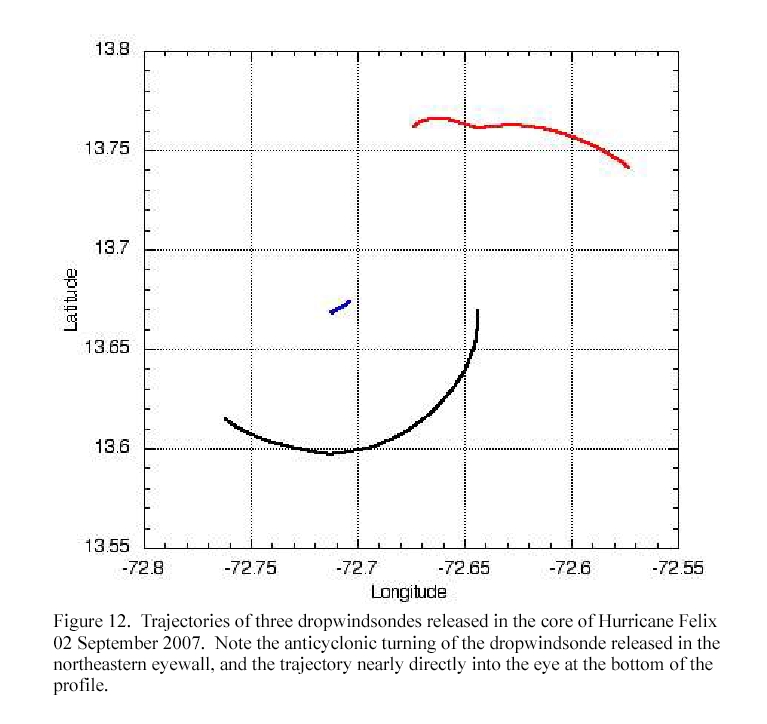
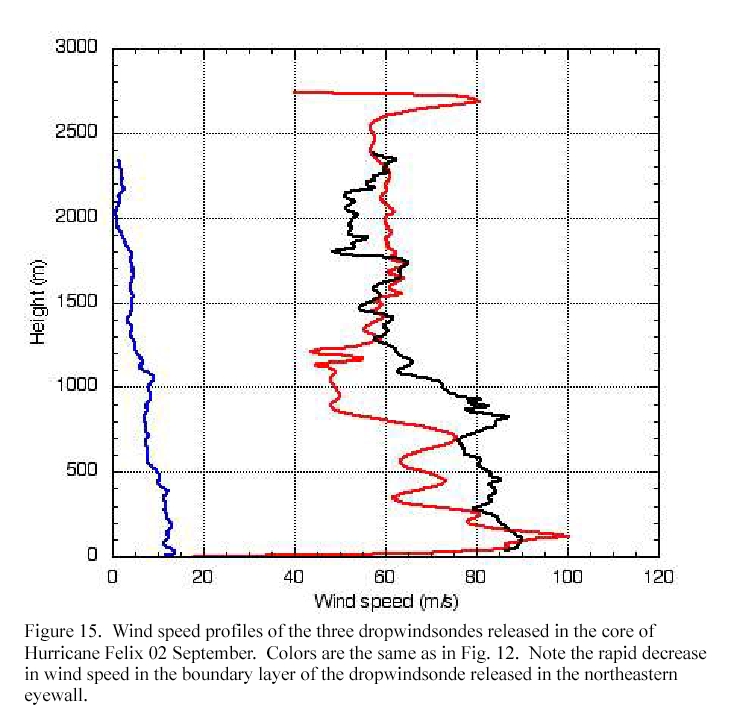
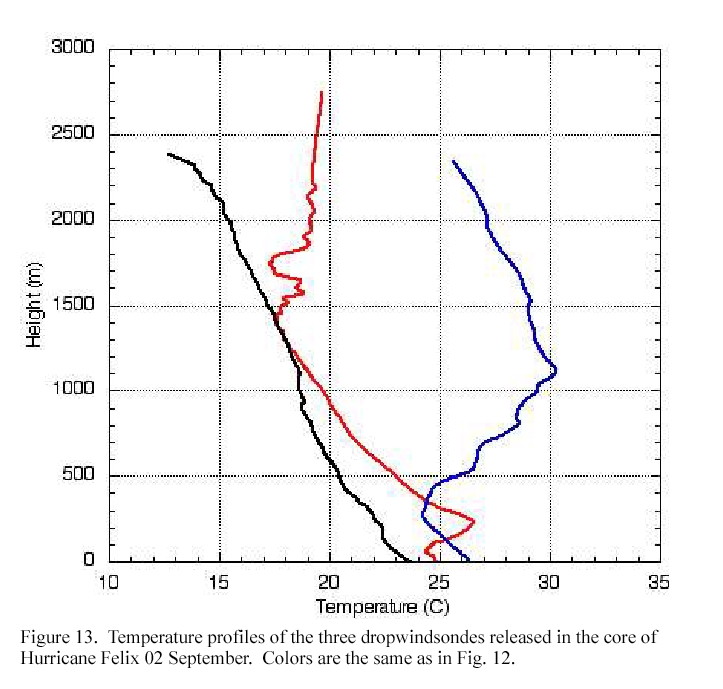 Upon entering the eye, the LF and TA radars went down, but the nose
remained available. Though the LF radar was restored, because of the
banking in the eye, it could not be used to see eyewall reflectivity
accurately. The pilots, flight director and scientists begandiscussing what
the safest way out of the eye was, while the pilots circled in the eye.
Since the eye was so small (about 11 nm across) the circles were very close
to the visual edge of the eye, causing concern that we could not turn fast
enough to remain in the eye. The discussion centered around whether we
wanted to rise, thus decreasing the potential to encounter the large up-
and downdrafts encountered on the way but increasing the potential to be
hit by hail, or to go down with the opposite effect. There was also concern
about whether there was a safe quadrant from which to exit. A decision
was made to exit the eye in the southwestern quadrant at 9000 ft. On the
way out, the flight director marked the center and a dropwindsonde was
released, reporting surface pressure of 936.5 hPa (about 20 hPa lower than
the previous report 4 h earlier) with winds of about 13 m/s at the
surface. Another dropwindsonde released in the southwestern eyewall reported
wind speeds of up to 90 m/s 145 m above the surface. Moderate turbulence and
constant lightning was reported during this penetration.
Upon entering the eye, the LF and TA radars went down, but the nose
remained available. Though the LF radar was restored, because of the
banking in the eye, it could not be used to see eyewall reflectivity
accurately. The pilots, flight director and scientists begandiscussing what
the safest way out of the eye was, while the pilots circled in the eye.
Since the eye was so small (about 11 nm across) the circles were very close
to the visual edge of the eye, causing concern that we could not turn fast
enough to remain in the eye. The discussion centered around whether we
wanted to rise, thus decreasing the potential to encounter the large up-
and downdrafts encountered on the way but increasing the potential to be
hit by hail, or to go down with the opposite effect. There was also concern
about whether there was a safe quadrant from which to exit. A decision
was made to exit the eye in the southwestern quadrant at 9000 ft. On the
way out, the flight director marked the center and a dropwindsonde was
released, reporting surface pressure of 936.5 hPa (about 20 hPa lower than
the previous report 4 h earlier) with winds of about 13 m/s at the
surface. Another dropwindsonde released in the southwestern eyewall reported
wind speeds of up to 90 m/s 145 m above the surface. Moderate turbulence and
constant lightning was reported during this penetration.
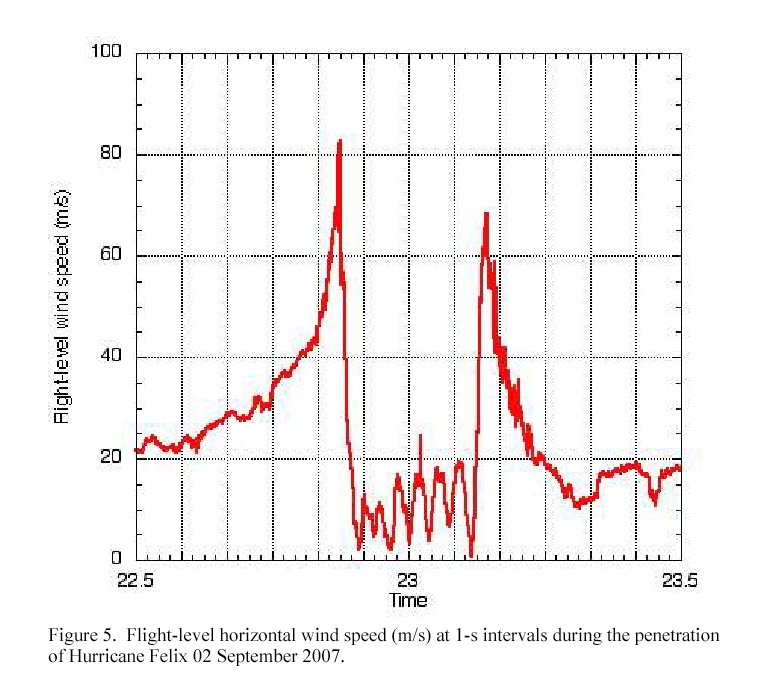

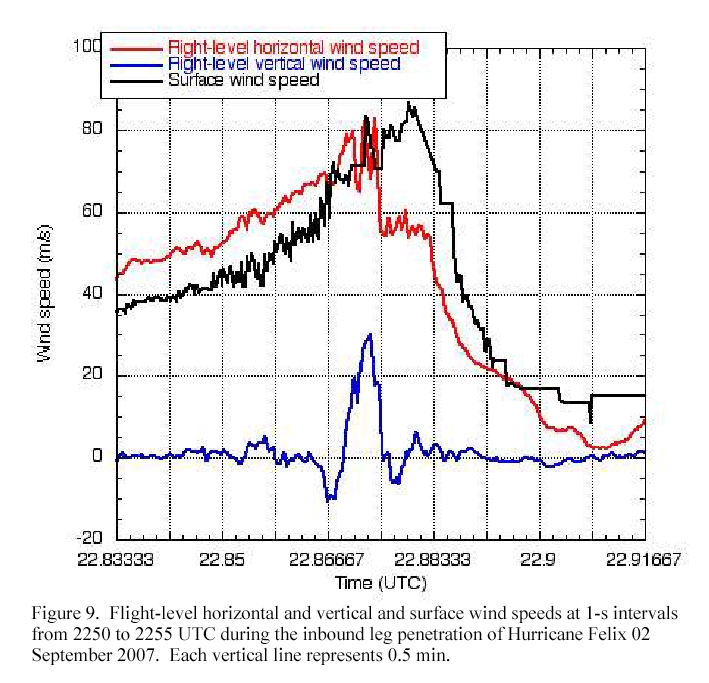 The aircraft then tracked radially outward and then back to St. Croix
without further science. During the ferry back, the automated Doppler wind
software ran successfully, and an analysis of the northeastern eyewall was
sent to NHC. No structural damage to the aircraft was reported the next
day. Some small "bubbles" were seen in the metal outside the doorway that
were not there before the flight, but these were to the outer fuselage and
did not impact the structure of the aircraft.
The aircraft then tracked radially outward and then back to St. Croix
without further science. During the ferry back, the automated Doppler wind
software ran successfully, and an analysis of the northeastern eyewall was
sent to NHC. No structural damage to the aircraft was reported the next
day. Some small "bubbles" were seen in the metal outside the doorway that
were not there before the flight, but these were to the outer fuselage and
did not impact the structure of the aircraft.
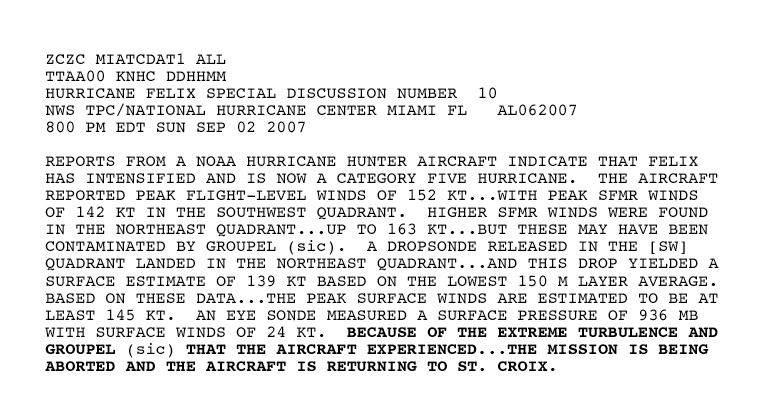 N42RF left St. Croix, USVI at 03:56 PM AST, and it recovered at St. Croix,
USVI at 9:35 AST.
N42RF left St. Croix, USVI at 03:56 PM AST, and it recovered at St. Croix,
USVI at 9:35 AST.
Sim Aberson
Mission Data:
gzipped NetCDF file
Page last updated Oct. 11, 2007
Return to Mission page.
 Takeoff was planned for 2000 UTC. However, the inertial navigation was
not set properly before takeoff, and the plane had to return to allow the
navigation to reset. Takeoff occurred about 40 minutes late. Because of
operational responsibility within a set time, the 10,000 ft legs were
switched to the first and third. Upon approach to the center, the endpoint
and midpoint dropwindsondes were released and provided good data. It was
apparent from both TA and nose radars that the storm had a very small eye
surrounded by a high-reflectivity ring, with purple on the nose radar.
Close to the eye, the flight-level and surface (SFMR) wind speeds were
relatively low, then began to spike rapidly. Upon penetration of the
eyewall, at 10,000 ft, the aircraft was pelted with hail, encountered
constant cloud-to-cloud lightning, and an updraft downdraft couplet that
caused the accelerometers to read +4G/-4G, higher than safe operations
allow, so the decision was made to abort the mission.
Takeoff was planned for 2000 UTC. However, the inertial navigation was
not set properly before takeoff, and the plane had to return to allow the
navigation to reset. Takeoff occurred about 40 minutes late. Because of
operational responsibility within a set time, the 10,000 ft legs were
switched to the first and third. Upon approach to the center, the endpoint
and midpoint dropwindsondes were released and provided good data. It was
apparent from both TA and nose radars that the storm had a very small eye
surrounded by a high-reflectivity ring, with purple on the nose radar.
Close to the eye, the flight-level and surface (SFMR) wind speeds were
relatively low, then began to spike rapidly. Upon penetration of the
eyewall, at 10,000 ft, the aircraft was pelted with hail, encountered
constant cloud-to-cloud lightning, and an updraft downdraft couplet that
caused the accelerometers to read +4G/-4G, higher than safe operations
allow, so the decision was made to abort the mission.












